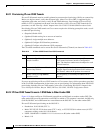
8-28
Cisco ONS 15310-MA SDH Reference Manual, Release 9.1 and Release 9.2
78-19417-01
Chapter 8 Management Network Connectivity
TCP/IP and OSI Networking
Figure 8-16 Level 1 and Level 2 OSI Routing
When you provision an ONS 15310-MA SDH for a network with NEs that use both the TCP/IP and OSI
protocol stacks, you will provision it as one of the following:
• End System—The ONS 15310-MA SDH performs OSI ES functions and relies upon an IS for
communication with nodes that reside within its OSI area.
• Intermediate System Level 1—The ONS 15310-MA SDH performs OSI IS functions. It
communicates with IS and ES nodes that reside within its OSI area. It depends upon an IS L1/L2
node to communicate with IS and ES nodes that reside outside its OSI area.
8.6.4.1 End System-to-Intermediate System Protocol
ES-IS is an OSI protocol that defines how ESs (hosts) and ISs (routers) learn about each other. ES-IS
configuration information is transmitted at regular intervals through the ES and IS hello messages. The
hello messages contain the subnetwork and network layer addresses of the systems that generate them.
The ES-IS configuration protocol communicates both OSI network layer addresses and OSI subnetwork
addresses. OSI network layer addresses identify either the NSAP, which is the interface between OSI
Layer 3 and Layer 4, or the NET, which is the network layer entity in an OSI IS. OSI SNPAs are the
points at which an ES or IS is physically attached to a subnetwork. The SNPA address uniquely identifies
each system attached to the subnetwork. In an Ethernet network, for example, the SNPA is the 48-bit
MAC address. Part of the configuration information transmitted by ES-IS is the NSAP-to-SNPA or
NET-to-SNPA mapping.
8.6.4.2 Intermediate System-to-Intermediate System Protocol
IS-IS is an OSI link-state hierarchical routing protocol that floods the network with link-state
information to build a complete, consistent picture of a network topology. IS-IS distinguishes between
Level 1 and Level 2 ISs. Level 1 ISs communicate with other Level 1 ISs in the same area. Level 2 ISs
route between Level 1 areas and form an intradomain routing backbone. Level 1 ISs need to know only
how to get to the nearest Level 2 IS. The backbone routing protocol can change without impacting the
intra-area routing protocol.
OSI routing begins when the ESs discover the nearest IS by listening to ISH packets. When an ES wants
to send a packet to another ES, it sends the packet to one of the ISs on its directly attached network. The
router then looks up the destination address and forwards the packet along the best route. If the
destination ES is on the same subnetwork, the local IS knows this from listening to ESHs and forwards
Level 2
routing
Area 1
IS IS
IS IS
Area 2
Domain
Level 1
routing
Level 1
routing
ES
131597
ES
ES
ES


















